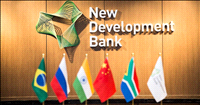Months after opening rupee trade with a host of countries in the Middle East and the neighbourhoods, Reserve Bank of India (RBI) is weighing the rupee’s transformation into an international currency.

India’s central bank is currently evaluating a report prepared by an Inter-Departmental Group (IDG) formed to examine the internationalisation of the Indian rupee. The IDG has prepared a road map for globalisation of the rupee.
Over the short term, the IDG has recommended the designing of a template and adopting a standardised approach for examining the proposals on bilateral and multilateral trade arrangements for invoicing, settlement and payment in Indian rupee and other local currencies.
The authorities, says the IDG, should make efforts to enable rupee as an additional settlement currency in existing multilateral mechanisms such as the ACU.
There should be a local currency settlement (LCS) framework for bilateral transactions in local currencies and operationalising bilateral swap arrangements with the counterpart countries in local currencies.
Besides, encouraging opening of rupee accounts for non-residents (other than nostro accounts of overseas banks) both in India and outside India, there should be an integration of Indian payment systems with other countries for cross-border transactions.
Financial markets must be strengthened by fostering a global 24x5 rupee market and promoting India as the hub for rupee transactions and price discovery.
Facilitating launch of BIS Investment Pools (BISIP) in rupee and inclusion of G-Secs in global bond indices would help widen the market.
Besides, according to the IDG, the FPI regime needs to be recalibrated by rationalising/harmonising the extant Know Your Customer (KYC) guidelines. The government should also provide equitable incentives to exporters for rupee trade settlement.
Over the medium-term, the IDG has recommended:
- A review of taxes on Masala bonds;
- International use of Real Time Gross Settlement (RTGS) for cross border trade transactions and inclusion of rupee as a direct settlement currency in the Continuous Linked Settlement (CLS) system;
- Examination of taxation issues in financial markets to harmonise tax regimes of India and other financial centres; and
- Allowing banking services in rupee outside India through off-shore branches of Indian banks.
Finally, the IDG feels that over the long term, India will achieve higher level of trade linkages with other countries and improved macro-economic parameters, and the rupee may ascend to a level where it would be widely used and preferred by other economies as a “vehicle currency”. Thus, the IDG recommends that in the long run, efforts should be made for inclusion of rupee in IMF’s SDR basket.
In preparing the report, IDG has noted the progress made by India’s external sector in the last three decades, after the economic liberalisation reforms were set in motion. Over the years, linkages of the Indian economy with the rest of the world in terms of trade and capital flows have increased.
In the last decade, India’s foreign exchange reserves have grown from $290.5 billion in August 2012 to $560.4 billion in August 2022. During the decade, foreign direct investment (FDI) flows into the country has also increased from $46.6 billion to $84.8 billion; imports have increased from $489.3 billion to $612.6 billion, and exports have grown from $306.0 billion to $421.9 billion.
Meanwhile, the international monetary and financial system also witnessed a steady decrease in the share of the US dollar in foreign exchange reserves of countries and the increasing usage of other currencies in trade invoicing and settlement. Simultaneously, the global financial system became more multipolar as reflected in the emergence of various bilateral and regional economic cooperation agreements. This, along with recent geopolitical developments, has set the stage for the emergence of various other currencies, including the rupee, as prospective currencies for use in international transactions.
The IDG has suggested a timeframe for the implementation of the various recommendations based on the institutional capacity, preparedness and priority of macro-economic supporting conditions.
The IDG views internationalisation of the rupee as a continuous process involving progressive capital account convertibility, wherein, the domestic currency increasingly acquires the character of a de facto freely convertible currency for international financial transactions. The size of an economy combined with the scale of external trade has a direct bearing on internationalisation of its currency. The IDG feels that rupee has the potential to become an internationalised currency as India is one of the fastest growing countries and has shown remarkable resilience even in the face of major headwinds. Further, India has made appreciable progress in terms of capital account convertibility, global value chain integration, setting up of GIFT city, etc. The higher usage of rupee in invoicing and settlement of international trade, as well as in capital account transactions, will give rupee a progressively international presence.
The IDG also reviewed the rise in prominence of the Chinese Yuan as an international currency (CNY as part of the IMF, SDR basket, composition of CNY in the foreign exchange reserves of various nations, etc), in spite of China retaining capital controls in many areas. China’s export-oriented manufacturing sector provides the basis for internationalisation of the Renminbi and this is supplemented by arrangements with partner countries.
The IDG notes that bilateral currency swaps can play an important role in promoting the use of rupee for settling foreign trade, thereby achieving internationalisation of the currency. Local Currency Settlement (LCS) frameworks also facilitate wider use of local currencies in current and capital account transactions thereby facilitating the ease of doing business and reducing dependence on hard currencies, it adds.
The internationalisation of a currency is also closely interlinked with the nation’s economic progress especially its prominence in global trade. The measures for promoting internationalisation of the rupee would involve steps towards parallelly liberalising the capital account, promoting international usage of the rupee, and strengthening financial markets.




















.jpg)









